How to hem a tulle with your own hands correctly and beautifully?
Content:
Not always ready-made curtains correspond to the length you need, and sometimes there is a desire or need to sew the curtains yourself from the fabric you like. How to hem the tulle, trim the edges and top so that the curtains look beautiful and elegant?
There is nothing complicated in such works. To hem the curtains, you will need a sewing machine, a minimal set of tools and materials: threads, needles, scissors. Also, in the process of working, keep an iron on hand - you will have to smooth out the gaps and seams after each line.
the cloth
Often called tulle is not only the fabric itself, but also all light transparent curtains. They can be made both from tulle and from other materials - most often it is organza, less often viscose and cotton.
Before starting work with a light synthetic fabric (tulle, organza), carefully examine the canvas and determine how the shared thread passes. Cut the canvas along it. Before trimming the edges, they must be steamed with an iron.
If your material is tulle, then to make it easier to navigate, you can stretch one thread from the fabric at a distance of 0.5-1 cm from the edge, and then cut along the formed line. With another fabric, such a trick will not work - you have to trim without a guideline.
Synthetic tulle is very slippery, so each edge is aligned one by one. It is advisable to put a dense cotton fabric under the material so that it glides less.
Threads and needles
For tulle and organza, thin strings of size 40 or less are selected. Their color should be in harmony with the color of the fabric. If the material shimmers, then take the thread a couple of tones lighter - light on a dark background does not stand out so much.
Thin needles are inserted into the machine. They should be sharp, since tulle is a very delicate material, it is easily pulled together and torn.
Preparatory work
Before work, cover the table with a cotton cloth - this will reduce the sliding of the curtain on the surface.
Very thin material is recommended to be sewn onto tissue paper. After sewing, the paper simply comes off.
Before starting to work on the sewing machine, sew a little on a small unnecessary section of tulle. If necessary, adjust the stitch length and thread tension. Seams are made with straight stitch with an average stride length (3-4 mm).
Side edges
First, we process the side edges of the curtains.
- The edge should be evenly cut and smoothed.
- We put the tulle inside out, wraps a hem of 1-2 cm. We invite it with an iron.
- Then once again we turn the edge 1-2 cm and iron. Thus we get a double hem.
- To make the material slip less, you can fix it with pins before ironing.
- We sew the seam on the machine at a distance of about 1-2 mm from the edge of the hem.
In the same way we process the second side edge of the curtain.
How to hem in length?
Some curtains have a beautiful finish at the bottom - lace, scallops, an original pattern. Sometimes weighting materials are inserted into the tulle - a special cord or weights. In this case, the adjustment of the length of the curtain is carried out only when processing the upper edge.
If the bottom of the canvas is simple, then it can be hemmed in several ways. The simplest is a double hem, the same as on the sides of the canvas.
The width of the hem is slightly larger than on the sides, and depends on the material of the curtain.
- In hard tissues (nylon, organza), the width of the turn should be at least 3 cm.
- The veil and light tulle can be rotated 2 cm.
- Plastic nets are recommended to be hemmed to a width of 1 cm.
More difficult in execution are the Moscow seam (American) or slanting inlay.
On a note
The bottom of curtains made of light fabrics is not recommended to be processed with a zigzag or overlock seam - this way the fabric lays worse and drapes.
Moscow seam
How to hem a tulle from organza? A good way is the so-called Moscow seam.
It is performed as follows.
- Tighten the edges of the curtains by 0.5-1 cm, iron.
- Perform a straight stitch at a distance of 2-3 mm from the edge of the hem.
- Excess gateway tissue is cut at a distance of 2-3 mm from the stitch. The material should not crumble.
- Once again, tuck the fabric, iron and sew. They try to get into the first line or make a seam at a distance of 1-2 mm from it. In this case, the first seam remains inside the hem.
In this way, a light, airy edge of the curtain is obtained with a minimum consumption of material for the doorway.
Slanting edging
This method is most often used for processing fabric with embroidery or tulle mesh.
For him, you will need a special foot that comes with the sewing machine. It can also be purchased at sewing stores. A snail foot will do. The bottom of the curtain is evenly cut, smoothed and tucked when sewing (the edge of the fabric is tucked into the foot).
Slanting inlay can be purchased at the store. This is an applied tape with pre-adjusted allowances; it can perform a decorative function (for example, inlays from satin). Sewing it is easy.
- Pin the tie to the bottom edge of the tulle with sewing pins.
- Check the joints.
- Sew in a straight line.
Top edge processing
Lastly, they start processing the upper edge of the curtain. Most often they use a curtain tape - it is convenient and beautiful. With the help of a curtain tape, or extrafor, you can get various folds and draperies of the canvas.
- Measure the desired length of the curtain. For practicality, it is recommended to make it 10-15 cm less than the distance from the floor to the cornice, but some prefer curtains “to the floor”.
- An allowance of 2-2.5 cm is left to the required length.
- Curtain tape is acquired based on the width of the curtain plus 5 cm on the side hem for each curtain.
- Tulle is laid with the wrong side up and tucked 2-2.5 cm, smoothed.
- A curtain tape is applied to the gateway. The laces and loops of the tape should be outside.
- The tape is pinned with pins and sewn at a distance of 1-2 mm from the top edge of the curtain.
- Having reached the edge, the cords are released, and the tape allowance is tucked inward by 2-2.5 cm on each side.
- Perform the second line on the lower edge of the tape, also backing 1-2 mm.
The curtain is smoothed and pulled together with a tape to the desired fold configuration.
That's all, tulle is ready to take its place on the window and delight you with its beauty.
Summing up, we say that if you buy ready-made curtains in the store, and do not sew them to order, then you will probably need to fit them in length. To hem a tulle, it is enough to have a sewing machine at home. Of course, you can also sew seams manually, but it is too laborious.
Most often, curtains made of tulle and organza are hemmed with a double hem. To save material or not to add weight to the curtain, you can use the so-called Moscow seam. And if there is a need for decorative decoration of the lower edge, then you can sew a beautiful braid or use a ready-made oblique trim.
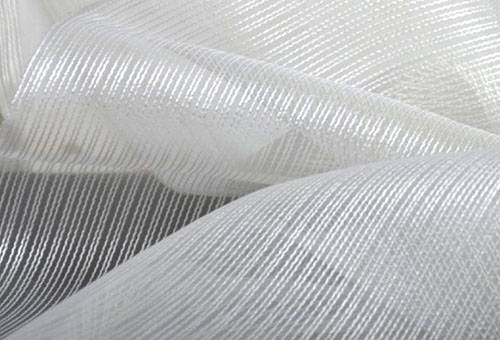
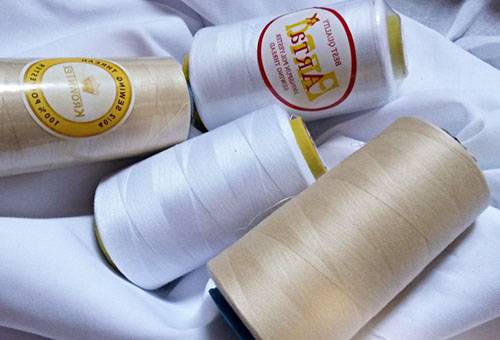
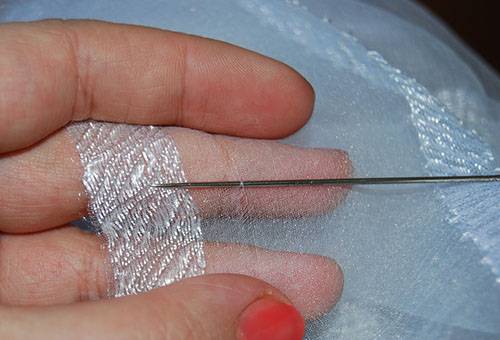
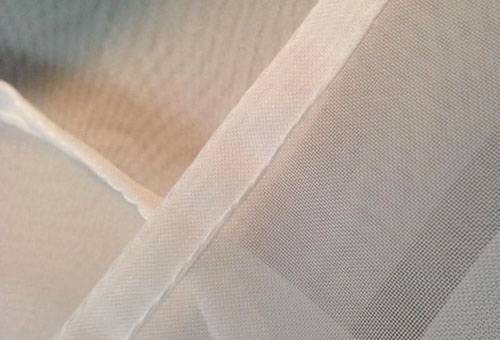
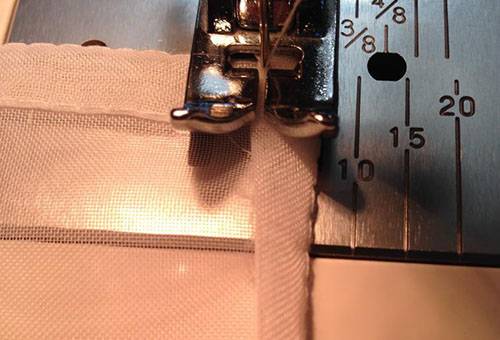
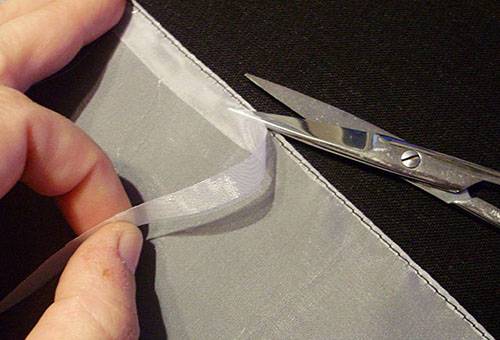
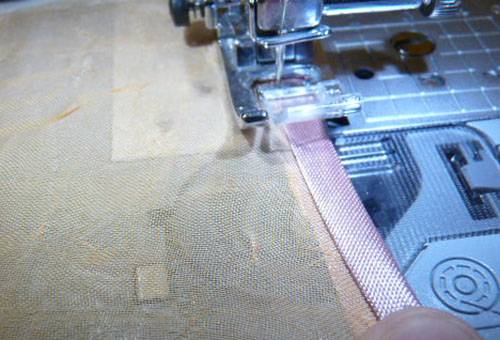
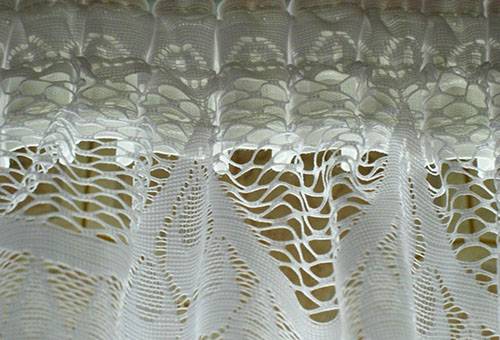

For the first time, I saw a recommendation for sewing fabric with tissue paper.Hence the questions for experienced needlewomen - have you tried that? Really convenient or unnecessary option? Does the paper need to be left outside or can it be sewn inside to secure the seam?
Natalia, I used the technique a couple of times and I can express my personal opinion about your questions. When working with a very thin, but not mesh, but a solid and almost transparent fabric, it really helps a lot. The lines are smooth, the material is not collected, it takes literally a few seconds to work. I leave the paper outside and then completely remove it. A friend sewed it once inside the seam and was pleased with the result, the curtain acquired a clear shape and did not bristle, but this was only before the first wash. After it, the paper gathered in lumps and had to be pulled out through the side seams.
Thank you for the detailed instructions for each important moment of working with tulle. Everything is very clearly painted, so it was not difficult for me to bring my curtain in the right form, spending only a couple of hours on it.
Thank you, everything is simple and affordable. The curtain lay for a month, it was even scary to approach her. I did all the work in 2 hours.
Thank you very much for the article! I went through the entire Internet and only here I found the answer to my question about the hem of the bottom in a zigzag fashion.
really liked the thread pocket for none of my friends have seen and I have 2 sets sewn to order but alas without such a necessary detail
Many thanks for the helpful information.
Thank you so much for the master class !!! Especially for a secret pocket, I've never seen this, long ends always annoy and cling. Took a note. Very clear and detailed explanation.